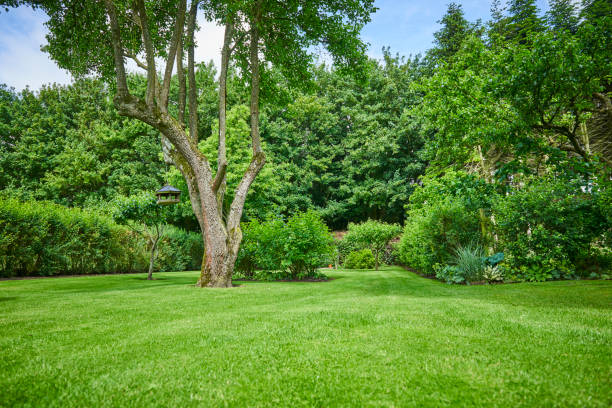Table of Contents
- Introduction
- Understanding The Basics of Yard Care
- Choosing the Right Grass for Your Climate
- Essential Yard Care Tools and Equipment
- Effective Watering Techniques for a Healthy Lawn
- Seasonal Lawn Maintenance Tips
- Natural Solutions for Pest Control
- Sustainable Practices for Eco-Friendly Yard Care
- Spotting Lawn Diseases and Their Remedies
Maintaining a beautifully lush lawn isn’t just a mark of pride; it adds value to your home and enhances your outdoor living experience. Understanding the essentials of yard care can make the journey less daunting and more rewarding. From choosing the best grass for your environment to employing sustainable practices, this comprehensive guide will give you the necessary knowledge to achieve optimal yard care results.
Whether you are a gardening novice experimenting with your green thumb or a seasoned enthusiast looking to refine your skills, the path to a thriving lawn involves thoughtful planning and consistent effort. With the proper adjustments for each season and equipped with essential tools, caring for your yard can transform from a cumbersome chore into an enjoyable hobby.
Understanding The Basics of Yard Care
The foundation of successful yard care lies in routine maintenance. It’s not just about the occasional mowing or watering but a commitment to understanding your lawn’s unique needs. Consistently mowing at the right height, watering deeply yet infrequently, and applying appropriate fertilizers ensure your lawn remains in prime condition. Key principles include identifying your soil type, assessing local climate challenges, and recognizing the grass species that thrive in your region. These factors collectively influence lawn upkeep, guiding your choices from seed selection to fertilization strategies.
Choosing the Right Grass for Your Climate
Selecting the appropriate grass type is critical in cultivating a healthy lawn. Your choice should hinge on your local climate, sunlight exposure, and prevailing rainfall levels. Various grass species, such as Bermuda, Kentucky Bluegrass, Zoysia, and Fescue, have unique needs and responses to environmental factors. For instance, Bermuda grass thrives under full sun, while Fescues are ideal for cooler climates. Using selection guides from the National Garden Association, you can match your environmental conditions with the most suitable grass variety, ensuring robust growth and resilience year-round.
Essential Yard Care Tools and Equipment
Equipping yourself with the right tools can significantly simplify lawn care, making the difference between a patchy yard and a pristine landscape. Essential tools include a quality lawnmower for optimal cutting, trimmers for edging pathways and flower beds, efficient sprinklers for widespread water distribution, and rakes for clearing debris. Investing in reliable equipment saves you time and enhances the precision of your lawn tasks, ultimately promoting the health of your greenery. Ensure your tools are well-maintained and replaced as needed to avoid unnecessary setbacks in your yard care regimen.
Effective Watering Techniques for a Healthy Lawn
Proper watering practices are vital to maintaining a lush, green lawn. D lawns need about an inch of water per week through rainfall or supplemental irrigation systems. Overwatering can lead to root rot and unwelcome fungal growth, while insufficient watering results in stress and wilting. Pay attention to the signs your lawn provides; footprints visible after walking on the grass typically indicate a need for water. Consider optimizing your watering schedule with guidance from the Environmental Protection Agency, adopting water-efficient technologies and strategies to reduce consumption while preserving lawn health.
Seasonal Lawn Maintenance Tips
Each season presents unique challenges and opportunities for lawn care. In spring, focus on aerating compacted soil and overseeding to fill bare or thin areas. As summer arrives, prioritize deep watering in the early morning and raise your mower blades to combat heat stress. With its cooler temperatures, fall is the ideal time for fertilizing and repairing bald spots. During winter, though growth slows, minimal intervention is required beyond clearing leaves and debris to prevent mold development. By adapting your care practices to the time of year, you can keep your lawn healthy and vigorous in all seasons.
Natural Solutions for Pest Control
Avoid chemical pest control whenever possible by opting for natural methods. Encouraging beneficial insects such as ladybugs, using natural repellents like garlic sprays, and fostering healthy grass growth through proper care can prevent pest infestations organically. Solutions like neem oil, diatomaceous earth, and homemade herbal sprays provide effective pest control without the harmful side effects commonly associated with synthetic options. These organic methods support not only the health of your lawn but also the surrounding environment.
Sustainable Practices for Eco-Friendly Yard Care
Sustainability in yard care is advantageous for the environment and the garden itself. Reduce chemical dependency by opting for organic fertilizers and herbicides, which improve soil health and biodiversity. Composting leaves and grass clippings naturally return essential nutrients to the soil, enhancing its structure and fertility. Mulching serves a dual purpose: conserving soil moisture and suppressing weeds. Adopting these sustainable practices can enhance your lawn’s resilience to pests and diseases while contributing to environmental well-being.
Spotting Lawn Diseases and Their Remedies
Awareness of common lawn diseases aids in prompt intervention and effective management. Brown patches, rust, and dollar spots are common issues caused by various fungi. Proper care, including thorough aeration, balanced watering, and consistent mowing, can prevent most diseases. However, when issues arise, identifying the symptoms early is crucial. Treatment options range from cultural controls, like adjusting mowing heights, to using specific organic or chemical treatments judiciously. Employing these methods only when necessary ensures a swift restoration of your lawn’s health and aesthetic appeal.






